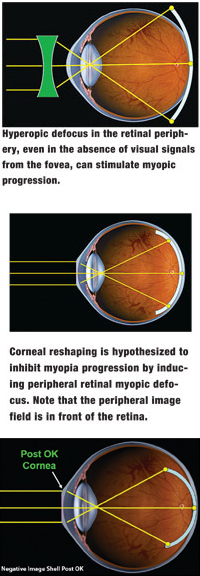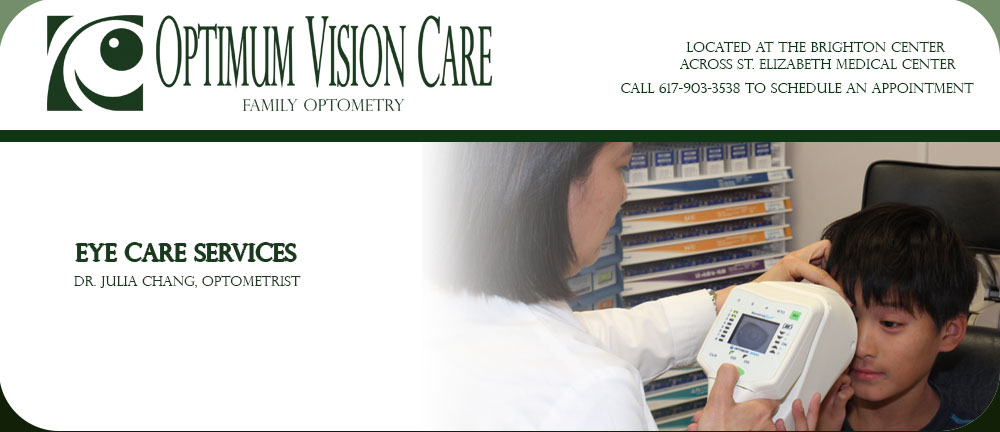The myopic population is growing worldwide. In some Asian countries, almost 80% of children in high school are myopic. The myopic population in United States has increased 66% over the past 30 years, the rate went from 25% to 41.6% in the group of age 12-54. Myopic patients have a greater incidence of cataract. Individuals with myopia greater than 6.00 diopters will have a greater risk of devoloping glaucoma, retinal detachments, chorioretinal atrophy and lacquer cracks. Most of vision researchers agree that there is a public health need to prevent the onset or progression of myopia.
There are many factors to contribute to our increasing myopia population especially in age 7 to 18. Both nature (genetic predisposition) and nurture (environment) still play important roles for children’s vision development. Given the prevalent usages of computerization and increased near work, myopia has become a more common visual complaint. Young children usually have good vision, and then develop myopia later at school age. Myopic change in the eye is usually permanent. Any treatment will not “cure” the myopia, but to prevent it from progressing as early as possible.
There are many ongoing researches looking for answers to what cause the eye to become more nearsighted, and hopefully we can intercept that pathway early enough to stop a child becoming more nearsighted. Many clinical approaches have been studied and monitored, including soft contact lenses, RGP (rigid gas permeable lenses), under-correction (purposely less prescription), pharmaceutical (cholinergic antagonists) and Orthokeratology (corneal reshaping). Among these methods, applying Atropine (a cholinergic anatagonist) might work, but it is not practiced in the USA for myopia control in children due to severe side effects. On the other hand, Ortho-K treatment has been proven to be safe and effective.

The prevailing evidence indicated that the peripheral of our retina (the neural tissue in the back of our eyes) control the axial growth of our eyes. When the eye grows axially, it becomes more myopic. The curvature of regular glasses and contact lenses actually make the image focus behind the peripheral retina that actually facilitates the eye growth, hence more myopic. However, the corneal curvature after Ortho-K treatment actually makes the image focus in front the peripheral retina, which in turn discourages axial eye growth. Many randomized longitudinal researches have been conducted in different countries, and they have shown very promising result of myopia management for pediatric population. Though the molecular signal for this control mechanism has yet to be identified, Ortho-K has become the choice of treatment to slow down myopia progression.
Based on the same mechanism, many options other than Ortho-K can also be applied. One option is multifocal soft contact lenses with distance at the center, which mimics the effect of Ortho-K to provide a relative “myopic” focus at the periphery retina. However, each retina might have different prolate shape at the periphery; the multifocal add might be different for each individual to be effective. Another option is the design of spectacle glasses to have a similar peripheral defocus pattern. It is currently available in Asia (called MyoVision). However, to make sure the lenses stabilize properly will be the challenge.
Researches worldwide continue to find the mechanism and effective ways to prevent the onset of myopia at early age. It is the evidence-based research results that will guide our clinic approaches for myopia management. One question I always get from concerning parents is “why is my son’s (daughter’s) eyesight getting worse? Is there anything we can do to stop the nearsightedness from progressing?” The answer is yes, yet there is no guarantee, the future of your child’s vision might depend on what you do today.
Studies that show evidence that Orthokeratology has the ability to slow down the progression of Myopia in children:
LORIC (Hong Kong) – The longitudinal orthokeratology research in children. Curr Eye Res. 30(1): 71-80
CANDY (USA) – Conrolling Astigmatism and Nearsightedness in Developing Youth http://www.wavecontactlenses.com/download/candy.pdf
CRAYON (USA) – Corneal reshaping and yearly observation of nearsightedness Br J Ophthalmol. 93(9): 1181-5
MCOS (Spain) – Myopia Control with Orthokeratology Contact Lenses in Spain https://www.ncbi.nlm.nih.gov/pubmed/22729437
ROMIO (Hong Kong) – the Retardation of Myopia in Orthokeratology study http://clinicaltrials.gov/ct2/show/NCT00962208
SMART (USA) – Stabilization of Myopia through Accelerated Reshaping Technologies Contact Lens Spectrum
TO-SEE (Hong Kong) – Toric Orthokeratology – Slowing Eye Elongation http://clinicaltrials.gov/ct2/show/NCT00978692
References:
1. Saw SM, Gazzard G, Shih-Yen EC, Chua WH. (2005) Myopia and associated pathological complications. Ophthalmic Physiol Opt. 25(5): 381-91
2. Vitale S, Sperduto RD, Ferris FL 3rd. (2009) Increased prevalence of myopia in the United States between 1971-1972 and 1999-2004. Arch Ophthalmol. 2009 Dec;127(12):1632-9
3. Lin LL, Shih YF, Hsiao CK, Chen CJ (2004) Prevalence of myopia in Taiwanese schoolchildren: 1983 to 2000. Ann Acad Med Singapore 33: 27-33.
4. Smith EL 3rd, Hung LF, Huang J, Blasdel TL, Humbird TL, Bockhorst KH. (2010) Effects of optical defocus on refractive development in monkeys: evidence for local, regionally selective mechanisms. Invest Ophthalmol Vis Sci. 51(8):3864-73 Free full text
Related Links:
